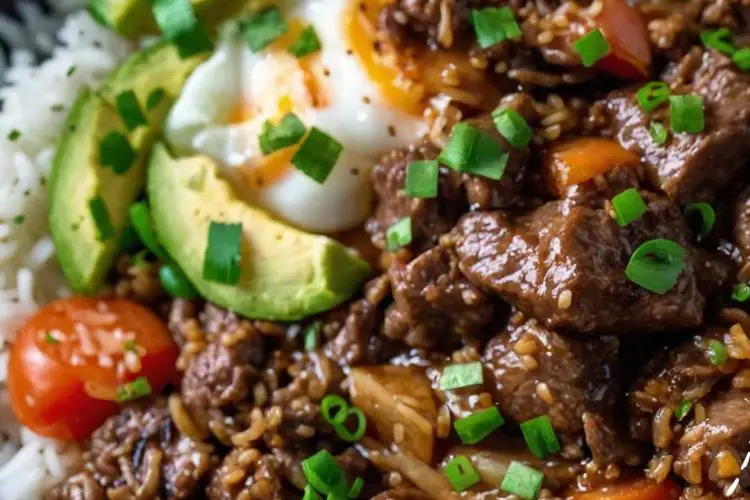Before diving into the deliciousness of Korean beef rice bowls, it’s worth considering what to serve alongside this dish. A few thoughtful pairings can elevate your dining experience:
Kimchi: This fermented Korean side dish provides a spicy, tangy crunch that contrasts beautifully with the savory beef. Plus, it’s a great way to incorporate probiotics into your meal.
Pickled Vegetables: With their bright flavors and crunchy texture, pickled radishes or cucumbers can brighten up the meal. They are refreshing and complement the richness of the beef.
Leafy Greens: A simple salad made with fresh greens or steamed bok choy can add a lightness to the meal. Toss them in a sesame dressing for added flavor.
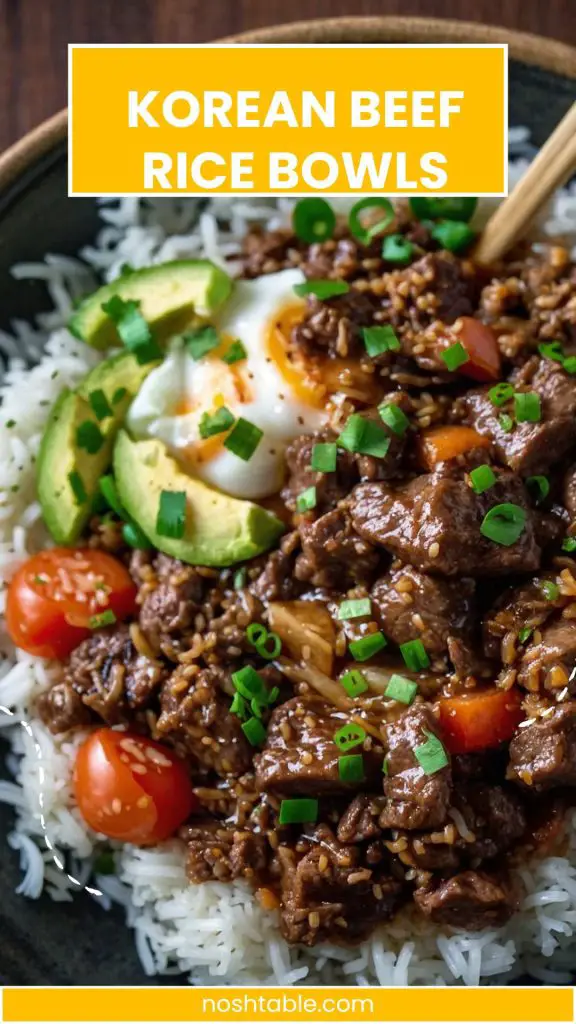
Korean beef rice bowls are a delightful meal that combines savory flavors and warming spices into a bowl of comfort. Just thinking about it makes my mouth water. Picture this: tender, flavorful beef mingling with a sweet and savory sauce, all topped with fresh green onions and toasted sesame seeds, served over fluffy white rice. It’s a dish that brings people together, whether at a family dinner or a casual get-together with friends.
As a food enthusiast and registered dietitian, I’ve spent countless hours experimenting in the kitchen. Over the years, I’ve embraced Korean cuisine’s unique boldness and depth. This recipe balances flavors and ingredients perfectly, ensuring that each bite is a delight. Today, I’m excited to share my take on Korean beef rice bowls. Grab your apron, and let’s get started!
You Might Also Like These Recipes!
What is Korean Beef Rice Bowls?
Korean beef rice bowls essentially center around thinly sliced or ground beef, marinated in a savory-sweet sauce, and served over rice. The allure of the dish is not just in its taste but also in its vibrant presentation and versatility. You can easily customize the toppings and sides to fit your preferences.
Why This Recipe Works
Several factors make this Korean beef rice bowl recipe a winner. Here’s a deeper look into why you’ll keep coming back for seconds:
1. Quick to Prepare: This dish comes together in about 30 minutes. Perfect for busy weeknights or when surprise guests arrive. You can whip it up without breaking a sweat.
2. Flavor Packed: With ingredients like brown sugar and soy sauce, this bowl is bursting with umami. The heat from the chili flakes, combined with the ginger’s warmth, gives the beef a culinary punch that’s hard to resist.
3. Healthy and Nutritious: Using lean ground beef keeps the dish healthier than many takeout options. Plus, you can add in fresh vegetables to enhance the nutrients without sacrificing taste.
4. Versatile: The components of this dish can easily be customized. Have leftover veggies? Toss them on top. Prefer chicken or tofu? No problem! This recipe adapts well to what you have on hand.
Ingredients You’ll Need To Make This Dish
To make Korean beef rice bowls, gather the following ingredients:
- 1 pound lean ground beef (90% lean)
- 3 garlic cloves, finely minced
- 1/4 teaspoon ground ginger
- 1/4 teaspoon crushed red chili flakes
- 1/4 teaspoon freshly ground black pepper
- 1/4 cup firmly packed brown sugar
- 1/4 cup low-sodium soy sauce
- 2 teaspoons toasted sesame oil
- 1 teaspoon rice vinegar (optional)
- 2 cups hot cooked white or jasmine rice
- 1/2 teaspoon toasted sesame seeds
- Sliced green onions for garnish
How to Make Korean Beef Rice Bowls
Making this dish is a delightful journey that’s as simple as it is satisfying. Here’s how to do it in a few easy steps.
Step 1: Prepare the Beef Mixture
In a large skillet over medium-high heat, add the ground beef. Cook it until it’s browned and no longer pink. Break it up into small crumbles as it cooks. This should take about 5-7 minutes.
Step 2: Add Flavor
Once the beef is browned, drain any excess fat. Then, lower the heat to medium and add the minced garlic, ground ginger, crushed red chili flakes, and black pepper. Stir for about 1-2 minutes until the garlic is fragrant.
Step 3: Make the Sauce
In a small bowl, mix together the brown sugar, soy sauce, toasted sesame oil, and rice vinegar. Pour this sauce over the cooked beef mixture. Stir everything well and let it simmer for an additional 2-3 minutes. Allow the flavors to meld beautifully.
Step 4: Serve Over Rice
Scoop hot, cooked rice into bowls. Top generously with the beef mixture. Don’t be shy; load it up! Sprinkle with toasted sesame seeds and garnish with sliced green onions.
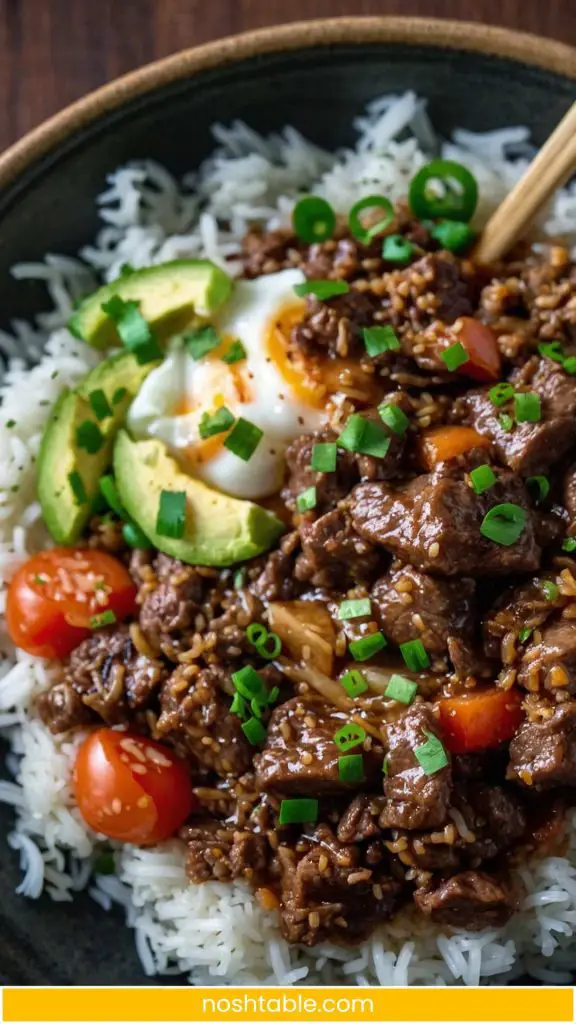
Tips & Tricks
Here are some handy tips to elevate your cooking experience:
- Use Fresh Ingredients: Fresh garlic and ginger make a significant difference in flavor. Dried spices work, but fresh is always better.
- Adjust the Heat: If you’re spice-averse, reduce the amount of crushed red chili flakes or omit them altogether.
- Try Marinating: For an extra depth of flavor, consider marinating the beef mixture in the sauce for at least 30 minutes before cooking.
- Double the Recipe: These bowls make excellent leftovers, so cook extra and save time for later meals!
- Experiment with Toppings: Don’t hesitate to add a fried egg on top or mix in steamed broccoli for more nutrition.
Nutrition Information
This dish is not only tasty but also quite filling. Here’s a quick nutritional breakdown per serving (assuming 4 servings total):
- Calories: 428
- Protein: 30g
- Fat: 18g
- Carbohydrates: 36g
- Fiber: 1g
How Do You Store The Leftovers?
If you find yourself with leftovers, don’t fret! Store the beef mixture and rice separately in airtight containers in the refrigerator. They’ll typically last 3-4 days. When you’re ready to eat, simply reheat everything in the microwave or on the stovetop until warmed through.
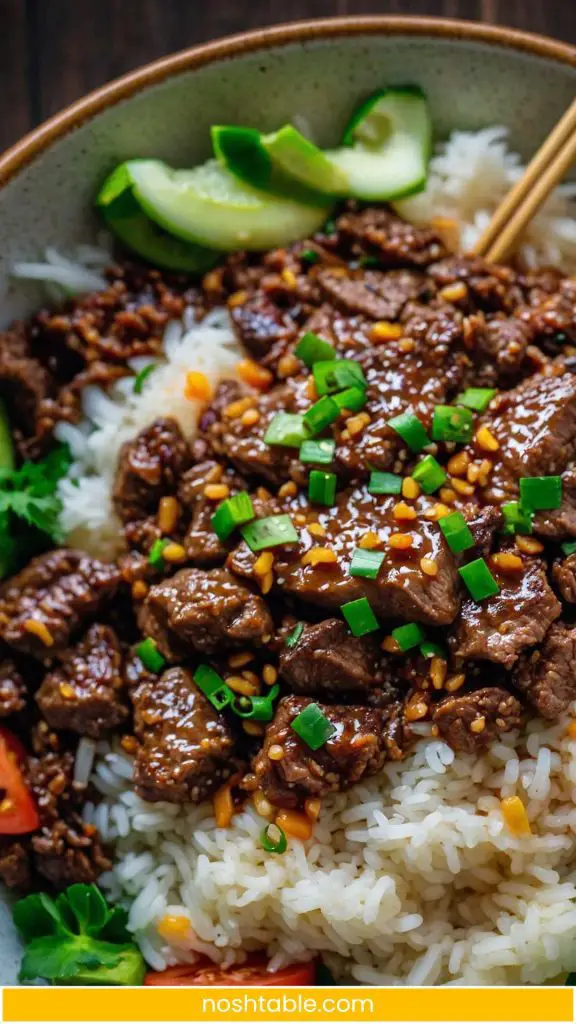
What Sides Would Complement Korean Beef Rice Bowls?
To create a well-rounded meal, consider these delicious side dishes:
1. Korean Side Dishes (Banchan): Traditional Korean pickles like radish kimchi or a cucumber salad (oi muchim) can elevate your meal’s authenticity and flavor profiles.
2. Steamed Vegetables: Broccoli or bok choy lightly steamed retain their crunch and pair perfectly with the beef’s richness.
3. Miso Soup: A small bowl of warm miso soup adds a comforting touch and balances out the meal.
What Alternatives Can You Use for the Ingredients if They Are Not Present in Your Kitchen?
Sometimes you have to get creative. If you’re missing certain ingredients, consider these alternatives:
1. Ground Turkey or Chicken: If you don’t have beef, ground turkey or chicken provides a leaner option that still absorbs flavors beautifully.
2. Coconut Aminos: If you’re watching salt intake, swap soy sauce for coconut aminos. They’re sweet and savory, just like soy sauce!
3. Maple Syrup: In a pinch, you can replace brown sugar with maple syrup. It’ll adjust the flavor slightly but still provide sweetness.
4. Olive Oil: If you don’t have sesame oil, use olive oil for cooking. Though the flavor will change, it will still be delicious.
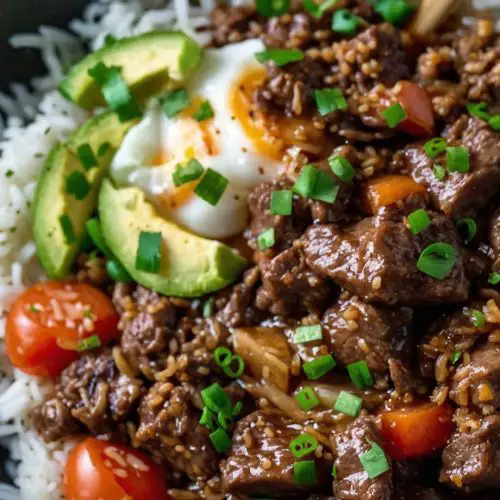
Korean Beef Rice Bowls
Equipment
- Skillet
Ingredients
- To make Korean beef rice bowls gather the following ingredients:
- 1 pound lean ground beef 90% lean
- 3 garlic cloves finely minced
- 1/4 teaspoon ground ginger
- 1/4 teaspoon crushed red chili flakes
- 1/4 teaspoon freshly ground black pepper
- 1/4 cup firmly packed brown sugar
- 1/4 cup low-sodium soy sauce
- 2 teaspoons toasted sesame oil
- 1 teaspoon rice vinegar optional
- 2 cups hot cooked white or jasmine rice
- 1/2 teaspoon toasted sesame seeds
- Sliced green onions for garnish
Instructions
- Making this dish is a delightful journey that’s as simple as it is satisfying. Here’s how to do it in a few easy steps.
Step 1: Prepare the Beef Mixture
- In a large skillet over medium-high heat, add the ground beef. Cook it until it’s browned and no longer pink. Break it up into small crumbles as it cooks. This should take about 5-7 minutes.
Step 2: Add Flavor
- Once the beef is browned, drain any excess fat. Then, lower the heat to medium and add the minced garlic, ground ginger, crushed red chili flakes, and black pepper. Stir for about 1-2 minutes until the garlic is fragrant.
Step 3: Make the Sauce
- In a small bowl, mix together the brown sugar, soy sauce, toasted sesame oil, and rice vinegar. Pour this sauce over the cooked beef mixture. Stir everything well and let it simmer for an additional 2-3 minutes. Allow the flavors to meld beautifully.
Step 4: Serve Over Rice
- Scoop hot, cooked rice into bowls. Top generously with the beef mixture. Don’t be shy; load it up! Sprinkle with toasted sesame seeds and garnish with sliced green onions.
Notes
- Use Fresh Ingredients: Fresh garlic and ginger make a significant difference in flavor. Dried spices work, but fresh is always better.
- Adjust the Heat: If you’re spice-averse, reduce the amount of crushed red chili flakes or omit them altogether.
- Try Marinating: For an extra depth of flavor, consider marinating the beef mixture in the sauce for at least 30 minutes before cooking.
- Double the Recipe: These bowls make excellent leftovers, so cook extra and save time for later meals!
Nutrition
Frequently Asked Questions
1. Can I use other proteins?
Absolutely! This recipe works well with chicken, pork, or even tofu for a vegetarian option. Just adjust cooking times accordingly.
2. Is this recipe suitable for meal prep?
Definitely! Make a big batch and portion it out for the week. Pack it in separate containers for easy, healthy lunches.
3. Can I freeze leftovers?
Yes. Store the beef mixture in a freezer-safe container. It can last for 2-3 months. Thaw in the refrigerator before reheating.
4. Is this dish gluten-free?
To make it gluten-free, substitute soy sauce with tamari or a gluten-free soy sauce alternative.
5. How spicy is this dish?
The spice level can be adjusted. Reduce or omit the chili flakes for a milder flavor that suits your taste.
6. Is rice essential for this recipe?
While rice is traditional, you can swap it for quinoa, cauliflower rice, or even lettuce wraps for a low-carb option.
Conclusion
Korean beef rice bowls are a delightful way to brighten your dinner table with bold flavors and comforting ingredients. This delightful dish proves that you don’t need hours in the kitchen to create something extraordinary. With its quick prep time, rich tastes, and adaptability, it’s no wonder this meal has become a favorite of mine.
So, fire up your stove and give this recipe a try! Pair it with your favorite sides, and savor every delicious bite. Whether you make it for yourself or share with others, this dish is sure to impress. Happy cooking!

